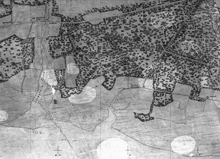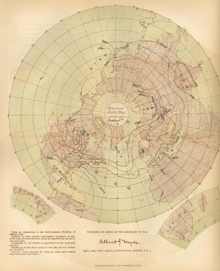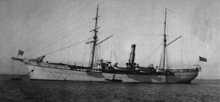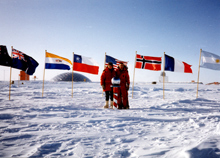Foundations
From our beginnings in 1807 to our recognition in 1970, NOAA has grown with the nation. In Foundations, our offices and programs trace their origins and relive their histories, telling the stories of the people, ideas, events, and breakthroughs that are the foundations upon which we stand today.
The Early Years
The seeds of NOAA were planted early in the 19th century. Throughout the early years of our country, the roots of NOAA took hold and the seedlings grew, flourished, and gave rise to an organization that works for the American people every day.
Finding Our Way: Charting and Navigation

The first topographic map created by the Survey was originally a single, long and narrow sheet, about two feet wide and over nine feet long.
NOAA’s roots are planted in America’s oldest scientific agency: the Survey of the Coast. Created in 1807 by President Thomas Jefferson to provide nautical charts to the American maritime community for safe passage into American ports and along our extensive coastline, this earliest agency laid the groundwork for a legacy of products to enhance the safe and efficient navigation of our nation’s waterways. From the original mandate to survey the U.S. coastline, our charting and coastal mapping pieces have grown. Today, NOAA’s Office of Coast Survey holds more than 20,000 historical nautical charts and continually updates its collection of 1,000 current charts.
As our country grew westward in the 19th century, surveys were conducted around the nation. To ensure that maps and charts would align with one another, surveyors needed a common reference system. Following the high standards for accuracy and scientific integrity of the first Survey of the Coast Superintendent Ferdinand Hassler, a national geodetic control network was built. Today, we manage this network, the National Spatial Reference System, providing a consistent coordinate system for position (latitude and longitude), elevation, distance and direction between points, and how these values change over time.
Monitoring Our Weather

Dated October 1, 1877, this map was produced by General Myer's division in Washington, DC. The map is based on daily synchronous weather observations made in the U.S., Europe, and ships at sea. This map is a testament to the cooperation Myer received around the world and his commitment to creating an international weather observation network.
In 1870, the first government agency to provide weather observations and warnings was established within the U.S. Army. The Weather Bureau began in 1890, when Congress transferred these services to the Department of Agriculture. Building on the innovative ideas of men like Brigadier General Albert J. Myer and Cleveland Abbe, the Weather Bureau published its first Washington, DC weather map, established the first hurricane warning service, and began regular kite observations within its first thirty years of existence. From these “firsts,” this service would evolve its scope and capacity, becoming the National Weather Service in 1970.
Today, we are the primary source of weather data, forecasts, and warnings for the United States. Television weathercasters and private meteorology companies prepare their forecasts using our information. We are also the official voice for issuing warnings during life-threatening weather events in the United States.
Taking to the Skies: Satellites

First television image from space, taken by TIROS-1 in 1960.
Our satellite operations grew out of the country’s early space program and a desire to study our planet from a vantage point high in the sky. The first weather satellite, TIROS-1, was launched in 1960. While in orbit for 78 days, TIROS-1 generated 23,000 pictures of the Earth, enhancing our understanding of meteorology and expanding our view of our planet, its natural wonders, and its place in the heavens.
Today, NOAA’s system of 16 satellites keeps watch over the nation, providing information for forecasting weather, studying ocean and coastal regions, detecting forest fires and volcanic eruptions, monitoring the ozone hole and the space environment, and much more.
Protecting Fisheries and Marine Mammals

Spencer Baird, the first Commissioner of the U.S. Commission of Fish and Fisheries, directs field sampling from a boat in waters off Woods Hole in the late 19th century.
The fishing industry has been important to the United States since the country’s earliest days. Formal efforts to protect fisheries date back to 1871, with the establishment of the nation’s first federal conservation agency: the U.S. Commission of Fish and Fisheries. This agency was charged with protecting and preserving “the Food Fishes of the Coast of the United States.”
This agency also applied systematic scientific studies towards the management and conservation of marine mammals. Efforts such as those to conserve the northern fur seals of the Pribilof Islands were based on studies examining the impacts of human activity on the larger ecosystem. This work led to the North Pacific Fur Seal Treaty of 1911, the first international treaty for wildlife conservation and a forerunner of the Marine Mammal Protection Act of 1972.
Over a century later, our National Marine Fisheries Service continues the legacy of its ancestor, taking a rational, scientific approach to the difficult, often contentions issues, of living marine resource management, seeking to balance competing public use and enjoyment of these resources, while preserving their biological integrity and sustainable use.
Studying It All: NOAA Research

In 1882, work started on the Albatross, the first research vessel ever constructed exclusively for fisheries research.
In 1882, the USS Albatross became the first government research vessel built exclusively for fisheries and oceanographic research. Over the course of three decades, the Albatross discovered more new marine species than any other research vessel and launched a future for our research programs and our fleet of research vessels.

Today's NOAA Corps officers serve in a much broader range of scientific endeavors than their predecessors, including in outposts as far away as the South Pole.
Today, NOAA researchers study the world in which we live, working to enhance weather forecasts; provide longer warning lead times for natural disasters; and enhance our understanding of our climate, oceans, and atmosphere. Our research takes place in laboratories across the country, as well as aboard a fleet of ships and planes operated by the NOAA Commissioned Officer Corps.
A Continuing Legacy
In 1970, amidst rising concerns for the health of our oceans and coasts, these and other elements were brought together with the creation of the National Oceanic and Atmospheric Administration.
From our 19th century beginnings, we have evolved into an operational science agency with conservation, management, and regulatory responsibilities. From delivering accurate nautical charts and positioning tools for navigational safety; to providing timely and precise weather, water, and climate forecasts; to managing fisheries and building healthy coastlines, we serve on America’s front lines.
(top)What’s Inside…

WSR-57 radar, which worked by sending out short bursts of energy in a beam that came from a slowly rotating antenna, was a major advancement that allowed NOAA scientists to better understand severe storm behavior.
How do you tell a tale as rich, diverse, and long as the story of NOAA? We decided to ask offices and staff from around our organization to tell the stories of the people, ideas, events, and major breakthroughs that have shaped the major activities of today, starting with their early origins. Some of these stories date back to NOAA’s beginnings in the 19th century, while others spin a more recent tale.
While these tales are individual vignettes, within some of the stories, you’ll see an overlap of our founding organizations. Although the elements of NOAA were created separately, throughout their histories, they have worked and grown together.

The National Weather Service Cooperative Observer Program, or “COOP,” was created in 1890. COOP was established to provide observational meteorological data and also help measure long-term climate changes. The COOP is the nation’s weather and climate observing network of, by, and for the people. This is a cooperative weather station in Granger, Utah, circa 1930.
The stories here, taken as a whole, weave together to tell the story that laid the foundation for NOAA’s 200 years of science, service, and stewardship.
In Foundations, you’ll learn how:
- A legacy of studying our ocean and coastal systems dating back to the early 1880s was driven by the boom in commercial transportation on the Great Lakes and the nation’s push westward.
- The historical record from NOAA tide and water level stations transcends the maritime history of the United States, from the days when clipper ships relied on tide predictions to navigate ports and harbors, to modern-day mariners that use real-time water levels to navigation huge ships through ports and under bridges.
- Research conducted throughout the 1960s involved researchers flying aircraft into thunderstorms to measure turbulence and how this research led to improved commercial airline safety guidelines in the vicinity of thunderstorms that are still in use today.
- In the mid-1800s, coral reefs were considered navigational hazards and efforts were investigated to reduce these “threats” to mariners. However, over the course of the 20th century, this convention has changed and NOAA has emerged a leader in the restoration and protection of these valuable marine treasures.
- Thirty years ago, NOAA flew the first WP-3D Orion “hurricane hunter” into Hurricane Bonny, in the eastern Pacific. That flight marked the beginning of a remarkable career by an aircraft that is still today considered a workhorse of NOAA and launched an era of NOAA flying its own aircraft directly into hurricanes to collect valuable data to increase our understanding of and ability to forecast these powerful storms.

On early, hand-drawn environmental sensitivity maps, information about specific plant and animal species or changes associated with seasons was limited. Details were provided in the introductory pages to each atlas or on the icons themselves. Above is an example from the Eastern Lake Michigan atlas prepared in 1985.
These are just some of the many stories that await you…
Topic List
Below is a list of topics with Foundation stories. Click on a topic to learn the story of the early origins of that topic within NOAA.
Atmospheric Research
Aviation Weather Forecasting
Climate Data Management
Climate Research
Coastal Ecosystem Research
Coastal Management
Coastal Mapping
Coral Reef Conservation
Diving Program
Environmental Satellites
Enivronmental Sensitivity Index Mapping
Fisheries Stewardship
Fisheries Science and Technology
Gravity Surveys
Marine Sanctuaries
National Estuarine Research Reserve System
National Spatial Reference System
Nautical Charts
NOAA Aircraft
NOAA Corps
NOAA Ships
Oceanographic Data Management
Ocean Research
Sea Grant
Severe Weather Watches and Warnings
Surveying Elevations
Surveying Using Satellites
Tides and Currents
Weather Observations
Weather, Ocean, and Climate Prediction
Weather, Water, and Climate Forecasts and Warnings
